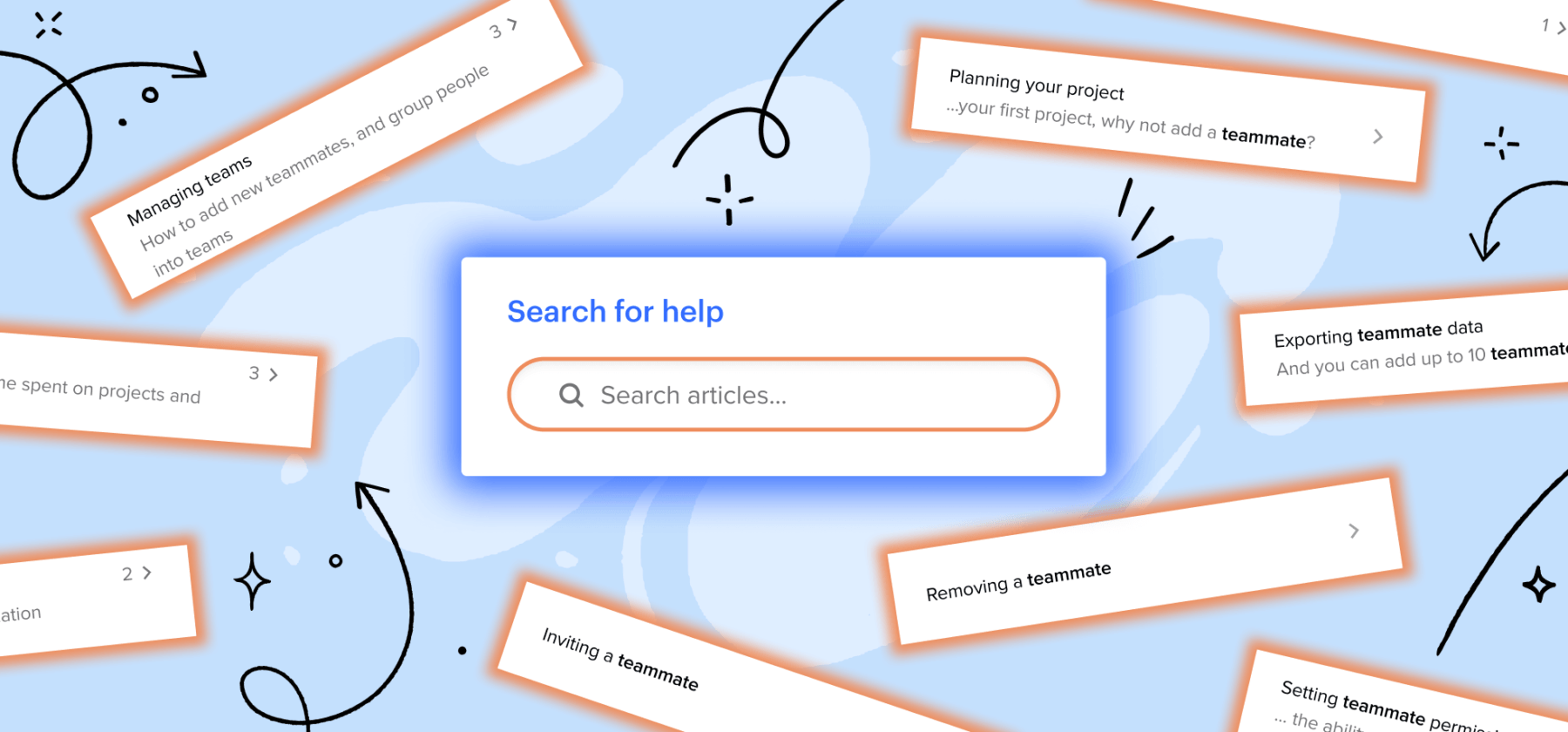
Easier help is better help: Announcing completely redesigned Articles in the Intercom Messenger
Main illustration: Jason Yim
If you can make something feel easier to do, people will be more likely to do it. That’s the simple thinking behind the latest update to our Messenger, released today.
We’ve redesigned the Messenger with an embedded help center experience to help you deliver the best self-serve support – now, your help content is fully searchable and browsable right in the Messenger, so support is always at your customers’ fingertips.
Our newly redesigned Messenger experience ensures customers can get the support they need, more conveniently than ever
The greater convenience and accessibility is going to dramatically increase user engagement with your help center content. Why? Because removing friction from a task is one of the single biggest factors in whether you’re likely to do it, as I recently discovered in an entirely different context.
Great products feel effortless
Around six months ago I finally took the plunge and sunk a lot of cash into a second vacuum cleaner – a cordless one. It was a hard decision to justify because our vacuum worked perfectly fine, so it felt like an irrational purchase. But everyone I knew who had one loved it, and there was something compelling about eliminating the minor hassle of moving while attached to a cord. So I went for it.
“Make something feel easier to do, and people will do it more often. It’s that old chestnut: reducing friction reliably translates to a good product”
Fast forward six months and what do I think? These things are fantastic! They don’t just make it more pleasant to do the same job, they change the job entirely. Before, I would rarely take out the big vacuum apart from the once-a-week big clean. Now I do a quick hoover almost daily, after doing the dishes, and it means every morning I come downstairs to a house that feels a bit nicer. Killing the cord made me vacuum more often, quite contentedly.
The product lesson? Make something feel easier to do, and people will do it more often. It’s that old chestnut: reducing friction reliably translates to a good product. And a user’s subjective perception of friction is as important as any objective measure of “better” that you can think of.
We’ve embedded the full help center experience in our Messenger
We’ve had articles in the Messenger since the last major update in 2018. It was our plug-in vacuum – pretty basic, but it did the job, bringing self-serve directly where you were inside the product. And if you wanted the full help center experience, you just had to open up a new tab and browse away — we’re talking a couple seconds of effort here. Even on mobile, embedded browsers are surely sufficient, right?
“We’ve made it much easier for your customers to get what they need, and increased customer engagement with Articles by up to 3x”
We didn’t think so, so we removed the cord. By redesigning our Messenger with an embedded help center experience, we’ve made it much easier for your customers to get what they need, and increased customer engagement with Articles by up to 3x. Just like the cordless vacuum, when you deliver the full product but make it feel easier to do, your customers will do more of it.
What’s new, exactly?
The Messenger still looks pretty much the same when you open it, but we’ve added a bunch of new features to help bring your self-serve support offering to the next level.
1. A full-fledged Articles experience in the web Messenger
We believe the Messenger is the best place to do self-serve, because it’s right there with you, inside the product, where you need it. No separate tabs; no disjointed experience. So we’ve massively upleveled the quality of that experience:
- First-class search abilities: We all know how search should work (search as you type, fast results, quickly navigate back and forth from results to content), and now this experience is available in the Messenger.
- Browse the content: You might assume search is dominant, but in fact we’ve seen from our Help Center that about half of users prefer to browse to find content, rather than searching. So we’ve fully integrated the browse experience as well. Indeed, what we’re seeing now is that 41% of users only search, 46% only browse, and 11% do both! So you simply have to enable browsing for customers.
- New wide view of Articles: Lots of articles are content-dense with images and videos as well as text. The standard narrow view of the Messenger just isn’t ideal for this form of content. So we stretched it! When you click to view an article, the Messenger morphs into wide mode to support a much better reading experience. It’s fluid and fast, and just feels right.
Collectively, these improvements make self-serve easier and faster. And the upside of that? Your users will do more of it. In A/B tests, we’ve seen a 3x increase in Articles views, a phenomenal uplift in engagement.
2. Self-serve first option
A real tension we hear about all the time from our customers is that the sheer volume of incoming conversations means they need their customers to self-serve more, but they’re reluctant to add hurdles that degrade the customer experience. After all, a great UX is often a key driver of why they chose Intercom in the first place. So we’ve added a self-serve first option with several ingredients:
- A carefully crafted UX for requiring self-serve: We make it clear this is the route to start a conversation, but bring you through a self-serve experience first. To make this experience smooth and clear, we present a new “Get help” card where users need to search or browse before they have the option to send a message to the team. (This is the mode that’s enabled on the Messenger for this page.)
- The ability to target this experience: You can show this experience to only a specific subset of your customers, enabling you to tailor the support experience for different customer segments.
- A gentler self-serve first approach: You can also just position the search box on top, so you’re not requiring self-serve, just nudging customers towards it.
3. Vastly improved Articles in Messenger on mobile, too
Have a mobile app? Good news – your app can now use the revamped Articles in Messenger, meaning you can offer a seamless self-serve support experience across web and mobile.
- More effective experience: We’ve taken the elegant design of Articles in the Messenger and given it a mobile twist. People love how easy it is to use, as well as how quick finding answers can be when it searches for Articles as you type. It’s accessible for large font sizes, screen readers, and keyboard navigation as well, so everyone can find their answers quickly.
- New Messenger settings, like self-serve first: Your customers will get the same experience in your mobile app as they do on your website as they’re encouraged to search articles first and encounter more prominent self-serve options through reordered cards on the Messenger.
- Developer tools for deeper integration: You can now open specific collections at any point in your app instead of the full help center, making your customers’ self-serve support experience more relevant. We even made it possible for you to build your own UI using information about your Articles, giving you full control of your customers’ experience.
- Updated conversation card design: Not only will the conversation card respect the settings in this release, we’ve redesigned the experience for mobile apps to make existing conversations more visible, reducing the likelihood of duplicates.
- Custom launcher icons: If you’ve added a custom icon to the Messenger launcher, that’ll now be shown in your mobile app as well. Make the Messenger feel more at home.
To take advantage of these new features, make sure you’ve installed the latest version of our mobile SDK or React Native wrapper.
4. Messenger self-serve reporting
Measure exactly how much value the Business Messenger is bringing to your self-serve support engagement by viewing Articles engagement within the Messenger. This reporting will make it easier for your team (and stakeholders) to see exactly how self-serve support is affecting your bottom line, and help you to identify opportunities for further optimization to make your conversational support strategy even more efficient.
How will the new Messenger benefit customer support teams?
The only question that matters when we add new features to our product is this: what problems are we solving? Here’s what these new features can do for your customer support team.
Faster resolutions for your customers
The help center is embedded in the product (both on web and mobile) and always there when your customers need it. You can even cater different types of support to different customers, for example, encouraging freemium customers to self-serve before writing in to your team.
Reduces inbound conversation volume
Free up your team’s time to focus on more complex queries, as customers with simpler questions begin to help themselves to your help center content. The latest version of Messenger gives your team more control over your customer support experience while solving customer problems more efficiently.
“By placing a first-class self-serve experience front and center, customers will learn they can often get their answer faster by themselves”
Encourages customers to see the value of self-serve support
Your help center articles are now located in the same place your customers go to reach out to your team. By placing a first-class self-serve experience front and center, customers will learn they can often get their answer faster by themselves, without waiting to hear from your support team.
Increases discoverability of your content
Your team spends valuable time creating helpful assets for your customers – are these resources being used to their full potential? Our new search and browse function means that customers can find what they need more easily and quickly, increasing engagement and return on investment as customers begin to help themselves more often.
Increases effectiveness of self-serve support
By identifying and addressing those questions that self-serve support can’t yet answer, you’ll continue to create a more effective and comprehensive support experience for your customers.
Create a seamless customer support experience with Intercom’s redesigned Messenger
Just like my cordless vacuum, making self-serve support easier to use means more people will use it. As your inbox volume falls, your support team will have more time to focus on those complex queries, building customer relationships one customer at a time. Try it out and see what you think by clicking on the Messenger icon at the bottom corner of this screen.







